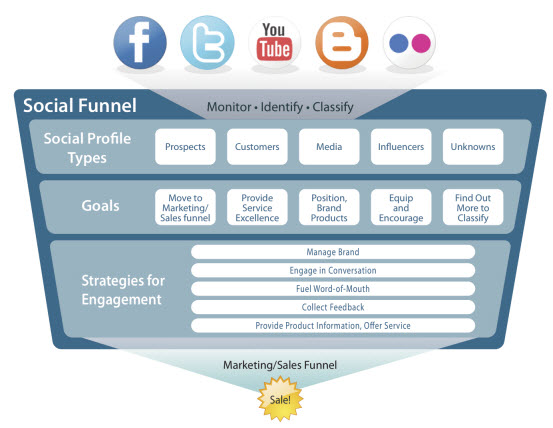The question of how to measure social media performance, particularly in a marketing context, continues to be one of the industry’s hottest topics. Although many people are aware that traditional metrics like page views, visitors, followers and likes are poor indicators of success, the vast majority of marketers I speak to still focus on these overly simplistic criteria. These numbers may be of little value, but at least they’re understandable.
The more sophisticated practitioners are turning toward metrics that indicate engagement. Examples include comments, retweets, shares and subscriptions. Now Awareness Networks has contributed some important new thinking to this topic with a free e-book entitled “The Social Marketing Funnel: Driving Business Value with Social Marketing.” (Full disclosure: I am quoted in the book but did not contribute meaningfully to the methodology and received no compensation.)
Awareness outlines five priorities that companies should define in becoming a best-in-class social marketer:
- Measure and Grow Social Reach
- Monitor Social Conversations
- Manage Social Content
- Practice SEO
- Measure and Analyze Social Activity
Not surprisingly, the company has tools that help in many of these areas, but that’s one reason its research is so useful: The recommendations are based upon the experiences of more than 100 customers.
The most successful of those are reporting direct correlations between social media marketing and sales, and they have certain practices in common. Most use at least three major social media channels, compared to less than two for the average company. They also have multiple presences within each channel, such as product-specific pages on Facebook. And they measure like crazy.
Nearly 80% of the companies Awareness surveyed use social media channels to identify and respond to customer service issues and two-thirds use them for prospecting. Remarkably, only 18% said they have “formal tracking process in place to manage processes and better understand success criteria.” In other words, a lot of social media is still being done with seat-of-the-pants justification.
That’s going to change as more sophisticated metrics emerge, however, and here’s where this report has particular value. It describes four measures of content effectiveness that take into account multi-channel activity: Content-to-Contact Ratio, Comments-to-Content Ratio, Comments-to-Profile Ratio and Content-to-Share Ratio. I won’t describe these metrics in detail – you can find that in the e-book – but each speaks directly to the value of engagement.
As businesses spread their wings across increasing numbers of social communities, they need to get a better handle on what’s working and what isn’t. The cost of maintaining an effective presence is only going to go up as the market gets crowded, and it won’t be acceptable for only one in five companies to have meaningful measurements in place.
As I have noted elsewhere, our current obsession with counting fans and followers is an artifact of old media thinking. Online marketing provides much richer options for understanding how people interact with our content. Awareness’ e-book is an important attempt to try to nudge marketers toward realizing the potential of the information they gather.

